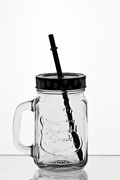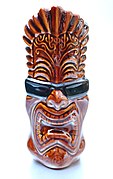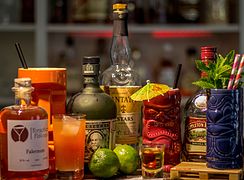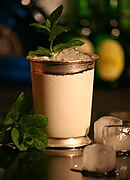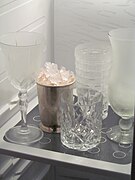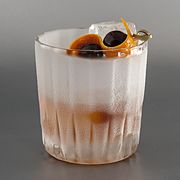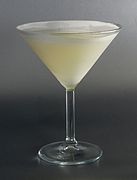Cocktail glass

Cocktail glass is the generic term for a drinking glass that is used almost exclusively for cocktails . Different shapes have emerged for different beverage groups.
Cocktail bowl
In the narrower sense and in the technical language, the cocktail glass is often referred to as the cocktail bowl, i.e. a curved bowl with a stem in which many short drinks are served. Cocktail bowls are often similar in their proportions to champagne bowls , but usually have a smaller capacity. They often hold no more than 100 ml of liquid, and the volume measured to the edge is regularly no more than 200 ml. Cocktail bowls from the 1950s are sometimes even smaller. In technical terms as well as in the Anglo-Saxon region, the cocktail bowl is also called a coupette , more rarely a coupe . A known since the 1930s or 1940s version with long stem and a hemispherical, is cup-shaped opening cuppa is Nick and Nora . Cocktails in stemmed glasses are usually served "straight up", that is, without ice in the glass and consequently without a drinking straw, which is why it is common to cool cocktail bowls before serving.
Old Cuban in a cocktail bowl
Blood and Sand in a Coupette
Martini glass
A special form of the cocktail bowl is the funnel-shaped ( conical ) martini glass , which has been widespread since the 1930s , which is also called martini bowl, martinikelch or cocktail spitz or English (Y-shaped) martini glass . According to the typical size of a martini cocktail (between 6 and 10 cl ), classic martini glasses usually have a total capacity of between 150 and 200 ml. Martini chillers are a special variant , which only appeared in this millennium. A martinicle without a stem rests loosely on a beaker filled with crushed ice , so that the drink continues to cool even after serving.
Typical martini glass with a dry martini
White Russian in a martini glass
More stemmed glasses
Other glasses in which cocktails can be served are
- Wine glasses , especially smaller goblets
- Cups, goblets
- Sparkling wine glasses such as champagne bowls, champagne flutes and champagne glasses
- Sour glasses (for sours ), which are similar in shape to southern wine or champagne glasses
- Margarita glasses (for margaritas ), a variant of the cocktail bowl that is particularly common in the United States
- Fancy glasses (especially for tropical and fruity cocktails), including the squall glass and the hurricane glass
- Balloon glasses, burgundy glasses
- Cognac drinker
- Irish coffee glasses
- Liqueur glasses, Cordial glasses, liqueur bowls
In addition, nosing glasses for tasting and pure enjoyment of spirits are also common at the bar .
Cordial glass, for liqueurs and pousse cafés
Beakers
Tumblers are mainly used for cocktails that are served with ice cubes in a glass and are common at the bar in numerous shapes and sizes, starting with schnapps glasses for so-called shots, which are served with only 2 to 4 cl , via whiskey glasses or whiskey tumblers 200 to 300 ml, highball and smaller long drink glasses with 200 to 300 ml up to large tumbler, Collins and long drink glasses with a volume well over 300 ml.
Small beaker, fizz glass
Tumbler , old fashioned glass, here large as DOF ("double-old-fashioned")
Highball glass , long drink glass
Other drinking vessels for cocktails
Examples of other drinking vessels are
- Punch bowl (for punch bowl )
- Punch glass (for hot punch )
- Grog glass (for grog )
- further glasses and mugs with handles for alcoholic hot drinks
- Mugs with handles and glasses with screw lids, a fashion since the 2010s
- Tiki mugs, usually made of earthenware and glazed vessels for exotic Tiki cocktails
- Silver cups, for example for Mint Julep
Prince of Wales in a silver goblet
Cooling cocktail glasses
Cocktail glasses are regularly pre-cooled (technically, frozen ) so that the drink served in them does not heat up again as quickly. Pre-cooling is particularly important for short drinks, which are served straight up after mixing with ice cubes, i.e. without ice, in stemmed glasses. In the case of long drink glasses, especially for drinks that are prepared in the guest glass yourself (technically built in the glass ), precooling is often dispensed with, since the ice cubes or crushed ice placed in the glass keep the drink sufficiently cold.
In gastronomy, cocktail glasses are often stored in freezers, so that a light layer of frost forms on the glass when they are served. Alternatively, cocktail glasses can also be cooled down at the counter by filling them with ice cubes and, if necessary, some water and leaving them to stand while the cocktail is being prepared in the mixing glass or cocktail shaker . Before straining the cocktail, the ice water is removed from the glass that has been cooled in the meantime. A third method, which only became less widespread in this millennium, is CO 2 glass freezers. Liquefied carbon dioxide flows from a gas cylinder via a spray head to the inside of the glass body. The glass cools down considerably within seconds and is covered with a layer of hoarfrost.
Old fashioned in a frosted tumbler
Last Word in a frosted martini glass








































